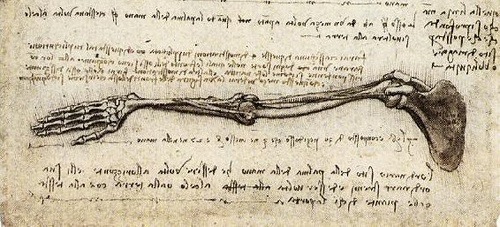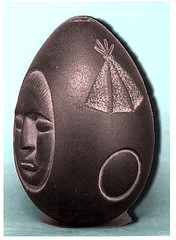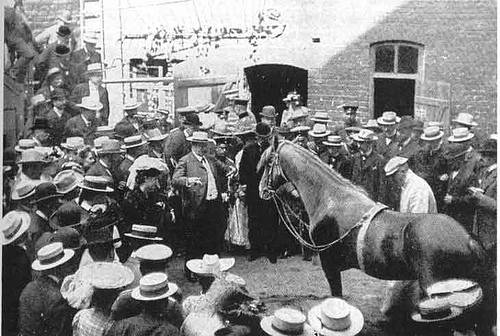
Leonardo da Vinci recorded most of his personal notes in mirror writing. Maybe he wanted to hide his ideas from the Church … or maybe, being left-handed, he didn’t want to smudge the ink.

Leonardo da Vinci recorded most of his personal notes in mirror writing. Maybe he wanted to hide his ideas from the Church … or maybe, being left-handed, he didn’t want to smudge the ink.
The following remarkable account of the stoppage of Niagara Falls, appeared in the Niagara Mail at the time of the occurrence: “That mysterious personage, the oldest inhabitant, has no recollection of so singular an occurrence as took place at the Falls on the 30th of March, 1847. The ‘six hundred and twenty thousand tons of water each minute’ nearly ceased to flow, and dwindled away into the appearance of a mere milldam. The rapids above the falls disappeared, leaving scarcely enough on the American side to turn a grindstone. Ladies and gentlemen rode in carriages one-third of the way across the river towards the Canada shore, over solid rock as smooth as a kitchen floor. The Iris says: ‘Table Rock, with some two hundred yards more, was left dry; islands and places where the foot of man never dared to tread have been visited, flags placed upon come, and mementoes brought away. This unexpected event is attempted to be accounted for by an accumulation of ice at the lower extremity of Fort Erie, which formed a sort of dam between Fort Erie and Buffalo.'”
— Barkham Burroughs’ Encyclopaedia of Astounding Facts and Useful Information, 1889

The frontage of the Saint-Georges Theater in Paris, transformed entirely with paint by muralist Dominique Antony.
This technique, where an effect emerges only when an image is viewed from a certain perspective, is called anamorphosis. Here’s a much earlier example.
“In the first place, God made idiots. That was for practice. Then he made school boards.” — Mark Twain
This puzzle has been attributed both to Lewis Carroll and to Albert Einstein:
Who drinks water? Who owns the zebra?

The magnificently named Lake Winnipesaukee Mystery Stone is just that — an odd carven stone, about 4 inches long, turned up by workmen digging a fence post in New Hampshire in 1872.
No one knows who carved it, when, or why. On one side are carved an ear of corn, a deer’s leg, and several other figures. One the other side are inverted arrows, a moon shape, a spiral, and some dots.
When the stone first came to light, the American Naturalist suggested that it “commemorates a treaty between two tribes.” But after an analysis in 1994, state archaeologist Richard Boisvert said that the holes drilled in the top and bottom are more consistent with power tools from the 19th or 20th century. He said that scratches in the lower hole suggest that the stone was placed on a metal shaft and removed several times. We’ll never know its real origin.
Between the 762nd and 767th decimal places of pi there are six 9s in a row.
It’s called the Feynman point, because physicist Richard Feynman said he’d like to recite 761 digits and end with “… nine, nine, nine, nine, nine, nine, and so on.”
Gordon Macdonald was the last British governor of Newfoundland. Despite the island’s fiercely independent nature, he openly campaigned for it to become part of Canada. In 1949 he succeeded, and two days before he returned to England, the Evening Telegram published a congratulatory poem:
The prayers of countless thousands sent
Heavenwards to speed thy safe return,
Ennobled as thou art with duty well performed,
Bringing peace, security and joy
Among the peoples of this New Found Land.
So saddened and depressed until your presence
Taught us discern and help decide what’s best for
All on whom fortune had not smiled.
Remember if you will the kindness and the love
Devotion and the respect that we the people have for Thee
— Farewell!
It was several weeks before the editors noticed it was an acrostic — read the first letter of each line.

Like Namibia’s Skeleton Coast, the Shipwreck Coast of Australia combines rare beauty with treacherous seas. Explorer Matthew Flinders said, “I have seldom seen a more fearful section of coastline.” More than 50 ships have been lost here, most of them supply ships carrying immigrants and convicts to Victoria and New South Wales in the 1800s, but the coast’s strangest victim may have come much earlier.
Periodically since 1836, travelers have reported stumbling on the wreck of a very old ship of “hard dark timber — like mahogany.” The descriptions are quite specific. Here’s a letter by Captain John Mason of Belfast, published in the Melbourne Argus on April 1, 1876:
Riding along the beach from Port Fairy to Warrnambool in the summer of 1846, my attention was attracted to the hull of a vessel embedded high and dry in the Hummocks, far above the reach of any tide. It appeared to have been that of a vessel about 100 tons burden, and from its bleached and weather-beaten appearance, must have remained there many years. The spars and deck were gone, and the hull was full of drift sand. The timber of which she was built had the appearance of cedar or mahogany. The fact of the vessel being in that position was well known to the whalers in 1846, when the first whaling station was formed in that neighbourhood, and the oldest natives, when questioned, stated their knowledge of it extended from their earliest recollection.
Despite well-financed searches in 1890, 1992, 1999, and 2004, no trace of the ship has been found. If it ever existed, it may have been the missing ship of Portuguese sea captain Cristóvão de Mendonça, which was wrecked in 1522. If that’s true, there’s a strange irony here: The introduction of livestock and pests from Europe have destabilized the local dunes, which may have buried all evidence of Australia’s first European visitor.

Illusionists know that people are eager to be fooled — some even participate unwittingly in their own deception. A striking example of this is Clever Hans, a trick horse who caused a sensation in the early 1900s. Using his hoof, Hans routinely tapped out correct answers to questions about math, reading, spelling and music. But an investigation showed that Hans’ real skill lay in reading his questioner’s body language, which always showed increased tension as he approached the final, “correct” tap.
In 1907, psychologist Oskar Pfungst actually took the horse’s place and found that he could get the right answer 90 percent of the time simply by watching the questioner’s posture and facial expression. This unconscious cueing is remembered as the “Clever Hans effect.”